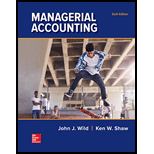
1
Department contribution statement
1
Explanation of Solution
| V Company | ||
| Department Contribution statement | ||
| Particulars | Department A | Department B |
| Sales | 800,000 | 450,000 |
| Cost of goods sold | 497,000 | 291,000 |
| Gross profit | 303,000 | 159,000 |
| Direct expenses | ||
| Salaries expense | 125,000 | 88,000 |
| 21,000 | 12,000 | |
| Insurance | 20,000 | 10,000 |
| Utilities | 24,000 | 14,000 |
| Maintenance | 7,000 | 5,000 |
| Total direct expenses | 197,000 | 129,000 |
| Departmental contribution to | 106,000 | 30,000 |
| Indirect expenses | ||
| Salaries expenses | 23,040 | 12,960 |
| Office expenses | 30,000 | 20,000 |
| Insurance expense | 4,200 | 1,800 |
| Depreciation expenses | 4,200 | 1,800 |
| Depreciation | 10,500 | 4,500 |
| Total indirect expenses | 67,740 | 39,260 |
| Net income(loss) | 38,260 | (9,260) |
Hence, department A has net income of $38,260 and department B has net loss of $9,260.
Working notes:
Given,
Department A sale is $800,000.
Department B sale is $450,000.
Calculate the total sale of department A and B,
Compute the percentage of sales of Department A,
Compute the percentage of sales of Department B,
Allocation of salary on the basis of sale
Given,
Salary is 36,000.
Percentage of A department sale is 64%.
Percentage of B department sale is 36%.
Computation of salary of A department,
Computation of salary of B department,
Allocation of insurance on the basis of square feet,
Given,
Department A square feet is $28,000.
Department B square feet are $12,000.
Calculate the total square feet of department A and B,
Compute the percentage of square feet of Department A,
Compute the percentage of square feet of Department B,
Given,
Insurance is $6,000.
Department A square feet is 70%.
Department B square feet are 30%.
Calculate the amount of the insurance on the basis of square feet,
Hence, amount of the insurance on the basis of square feet of department A and B are $4,200 and $1,800.
Allocation of the depreciation on the basis of square feet,
Given,
Department A square feet is $28,000.
Department B square feet are $12,000.
Calculate the total square feet of department A and B,
Compute the percentage of square feet of Department A,
Compute the percentage of square feet of Department B,
Given,
Depreciation amount is $15,000.
Department A square feet is 70%.
Department B square feet are 30%.
Formula to calculate the amount of the insurance,
Hence, allocation of the depreciation expense on the basis of the square feet of department A and B are $10,500 and $4,500.
Allocation of the office expenses on the basis of the number of the employees allocated to the department.
Given,
Number of employees in department A is 75.
Number of employees in department B is 50.
Calculate the total number of employees in department A and B,
Compute the percentage of employees in Department A,
Compute the percentage of employees in Department B,
Given,
Office expense amount is $50,000.
Percentage of the employees in the department A is 60%
Percentage of the employees in the department B is 40%
Calculate the amount of office expenses,
Hence, Office expense of the department A and b are $30,000 and $20,000.
2.
Elimination of department B
2.
Explanation of Solution
Here, it can be seen that total Indirect expenses of the department A is $67,740 and department B is $39,260. Net income of the department A and B are $38,260 and $9,260 respectively. Contribution of overhead at department A and B are positive with $106,000 and $30,000 respectively.
From the above data it can be said that department B comes to loss due to the indirect cost. So, it will be better to not eliminate the department B
Want to see more full solutions like this?
Chapter 9 Solutions
Managerial Accounting
- Brightview Components Ltd. expected an overhead cost of $425,000 for its packaging cost pool and an estimated 17,000 packaging operations. The actual overhead cost for that cost pool was $460,000for 18,200 actual packaging operations. The activity-based overhead rate (ABOR) used to assign the costs of the packaging cost pool to products is __arrow_forwardElba Industries recently reported an EBITDA of $12.5 million and a net income of $3.7 million. It had $3.2 million in interest expense, and its corporate taxrate was 40%. What was its charge for depreciation and amortization?arrow_forwardPedro Manufacturing expects overhead costs of $360,000 per year and direct production costs of $15 per unit. The estimated production activity for the 2023 accounting period is as follows: 1st 2nd 3rd 4th Quarter Units Produced 10,000 9,500 8,000 10,500| The predetermined overhead rate based on units produced is (rounded to the nearest penny): a. $9.47 per unit b. $10.00 per unit c. $8.05 per unit d. $11.25 per unitarrow_forward
- Please provide the accurate answer to this general accounting problem using valid techniques.arrow_forwardHello tutor please given General accounting question answer do fast and properly explain all answerarrow_forwardOn March 1, 20X1, your company,which uses Units-of-Production (UOP) Depreciation, purchases a machine for $300,000.arrow_forward

 AccountingAccountingISBN:9781337272094Author:WARREN, Carl S., Reeve, James M., Duchac, Jonathan E.Publisher:Cengage Learning,
AccountingAccountingISBN:9781337272094Author:WARREN, Carl S., Reeve, James M., Duchac, Jonathan E.Publisher:Cengage Learning, Accounting Information SystemsAccountingISBN:9781337619202Author:Hall, James A.Publisher:Cengage Learning,
Accounting Information SystemsAccountingISBN:9781337619202Author:Hall, James A.Publisher:Cengage Learning, Horngren's Cost Accounting: A Managerial Emphasis...AccountingISBN:9780134475585Author:Srikant M. Datar, Madhav V. RajanPublisher:PEARSON
Horngren's Cost Accounting: A Managerial Emphasis...AccountingISBN:9780134475585Author:Srikant M. Datar, Madhav V. RajanPublisher:PEARSON Intermediate AccountingAccountingISBN:9781259722660Author:J. David Spiceland, Mark W. Nelson, Wayne M ThomasPublisher:McGraw-Hill Education
Intermediate AccountingAccountingISBN:9781259722660Author:J. David Spiceland, Mark W. Nelson, Wayne M ThomasPublisher:McGraw-Hill Education Financial and Managerial AccountingAccountingISBN:9781259726705Author:John J Wild, Ken W. Shaw, Barbara Chiappetta Fundamental Accounting PrinciplesPublisher:McGraw-Hill Education
Financial and Managerial AccountingAccountingISBN:9781259726705Author:John J Wild, Ken W. Shaw, Barbara Chiappetta Fundamental Accounting PrinciplesPublisher:McGraw-Hill Education





